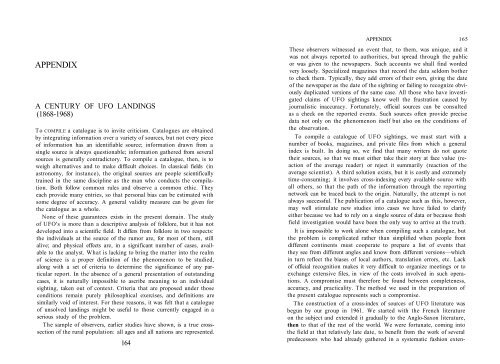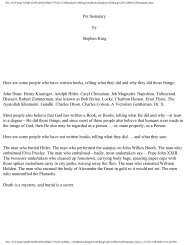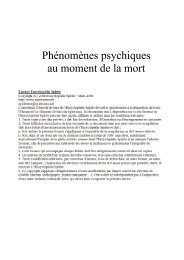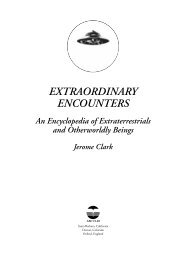Create successful ePaper yourself
Turn your PDF publications into a flip-book with our unique Google optimized e-Paper software.
APPENDIX<br />
A CENTURY OF UFO LANDINGS<br />
(1868-1968)<br />
To COMPILE a catalogue is to invite criticism. Catalogues are obtained<br />
by integrating information over a variety of sources, but not every piece<br />
of information has an identifiable source; information drawn from a<br />
single source is always questionable; information gathered from several<br />
sources is generally contradictory. To compile a catalogue, then, is to<br />
weigh alternatives and to make difficult choices. In classical fields (in<br />
astronomy, for instance), the original sources are people scientifically<br />
trained in the same discipline as the man who conducts the compilation.<br />
Both follow common rules and observe a common ethic. They<br />
each provide many entries, so that personal bias can be estimated with<br />
some degree of accuracy. A general validity measure can be given for<br />
the catalogue as a whole.<br />
None of these guarantees exists in the present domain. The study<br />
of UFO's is more than a descriptive analysis of folklore, but it has not<br />
developed into a scientific field. It differs from folklore in two respects:<br />
the individuals at the source of the rumor are, for most of them, still<br />
alive; and physical effects are, in a significant number of cases, available<br />
to the analyst. What is lacking to bring the matter into the realm<br />
of science is a proper definition of the phenomenon to be studied,<br />
along with a set of criteria to determine the significance of any particular<br />
report. In the absence of a general presentation of outstanding<br />
cases, it is naturally impossible to ascribe meaning to an individual<br />
sighting, taken out of context. Criteria that are proposed under those<br />
conditions remain purely philosophical exercises, and definitions are<br />
similarly void of interest. For these reasons, it was felt that a catalogue<br />
of unsolved landings might be useful to those currently engaged in a<br />
serious study of the problem.<br />
The sample of observers, earlier studies have shown, is a true crosssection<br />
of the rural population: all ages and all nations are represented.<br />
164<br />
APPENDIX 165<br />
These observers witnessed an event that, to them, was unique, and it<br />
was not always reported to authorities, but spread through the public<br />
or was given to the newspapers. Such accounts we shall find worded<br />
very loosely. Specialized magazines that record the data seldom bother<br />
to check them. Typically, they add errors of their own, giving the date<br />
of the newspaper as the date of the sighting or failing to recognize obviously<br />
duplicated versions of the same case. All those who have investigated<br />
claims of UFO sightings know well the frustration caused by<br />
journalistic inaccuracy. Fortunately, official sources can be consulted<br />
as a check on the reported events. Such sources often provide precise<br />
data not only on the phenomenon itself but also on the conditions of<br />
the observation.<br />
To compile a catalogue of UFO sightings, we must start with a<br />
number of books, magazines, and private files from which a general<br />
index is built. In doing so, we find that many writers do not quote<br />
their sources, so that we must either take their story at face value (reaction<br />
of the average reader) or reject it summarily (reaction of the<br />
average scientist). A third solution exists, but it is costly and extremely<br />
time-consuming; it involves cross-indexing every available source with<br />
all others, so that the path of the information through the reporting<br />
network can be traced back to the origin. Naturally, the attempt is not<br />
always successful. The publication of a catalogue such as this, however,<br />
may well stimulate new studies into cases we have failed to clarify<br />
either because we had to rely on a single source of data or because fresh<br />
field investigation would have been the only way to arrive at the truth.<br />
It is impossible to work alone when compiling such a catalogue, but<br />
the problem is complicated rather than simplified when people from<br />
different continents must cooperate to prepare a list of events that<br />
they see from different angles and know from different versions—which<br />
in turn reflect the biases of local authors, translation errors, etc. Lack<br />
of official recognition makes it very difficult to organize meetings or to<br />
exchange extensive files, in view of the costs involved in such operations.<br />
A compromise must therefore be found between completeness,<br />
accuracy, and practicality. The method we used in the preparation of<br />
the present catalogue represents such a compromise.<br />
The construction of a cross-index of sources of UFO literature was<br />
begun by our group in 1961. We started with the French literature<br />
on the subject and extended it gradually to the Anglo-Saxon literature,<br />
then to that of the rest of the world. We were fortunate, coming into<br />
the field at that relatively late date, to benefit from the work of several<br />
predecessors who had already gathered in a systematic fashion exten-





